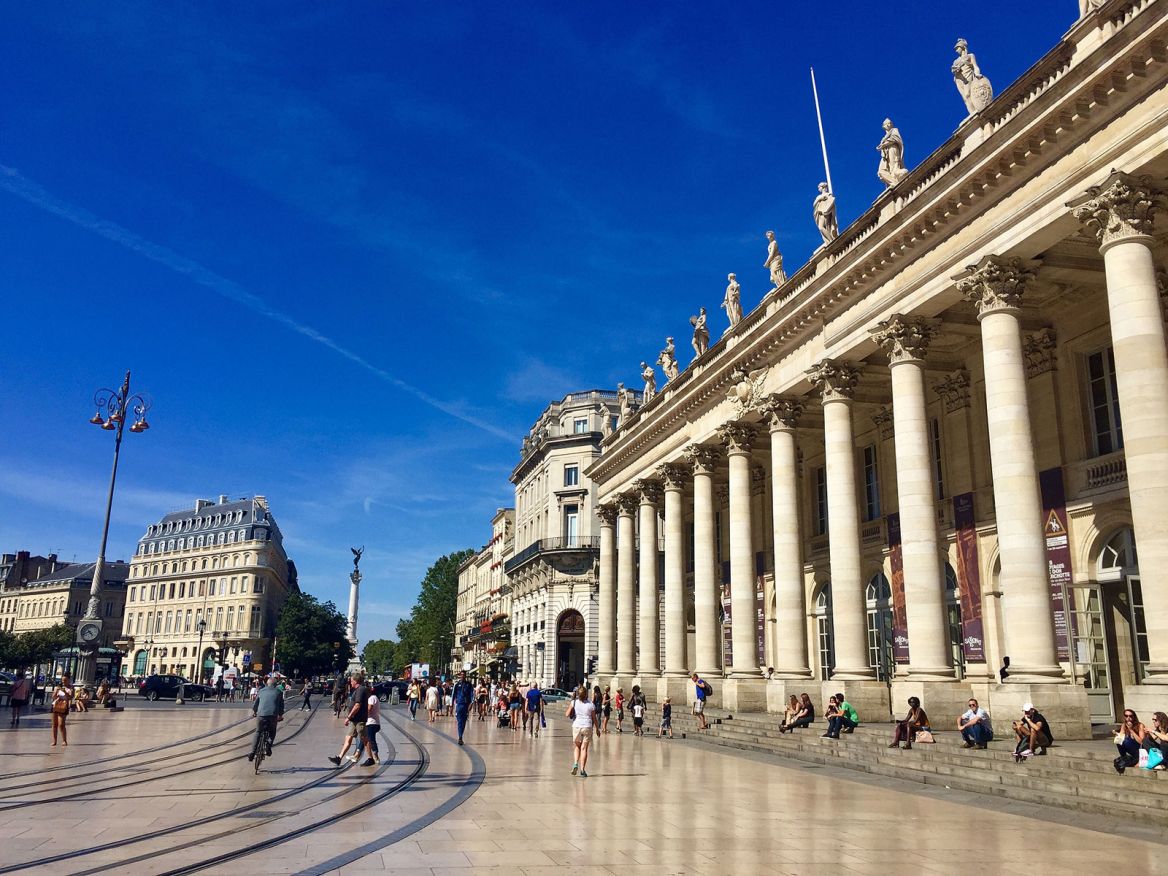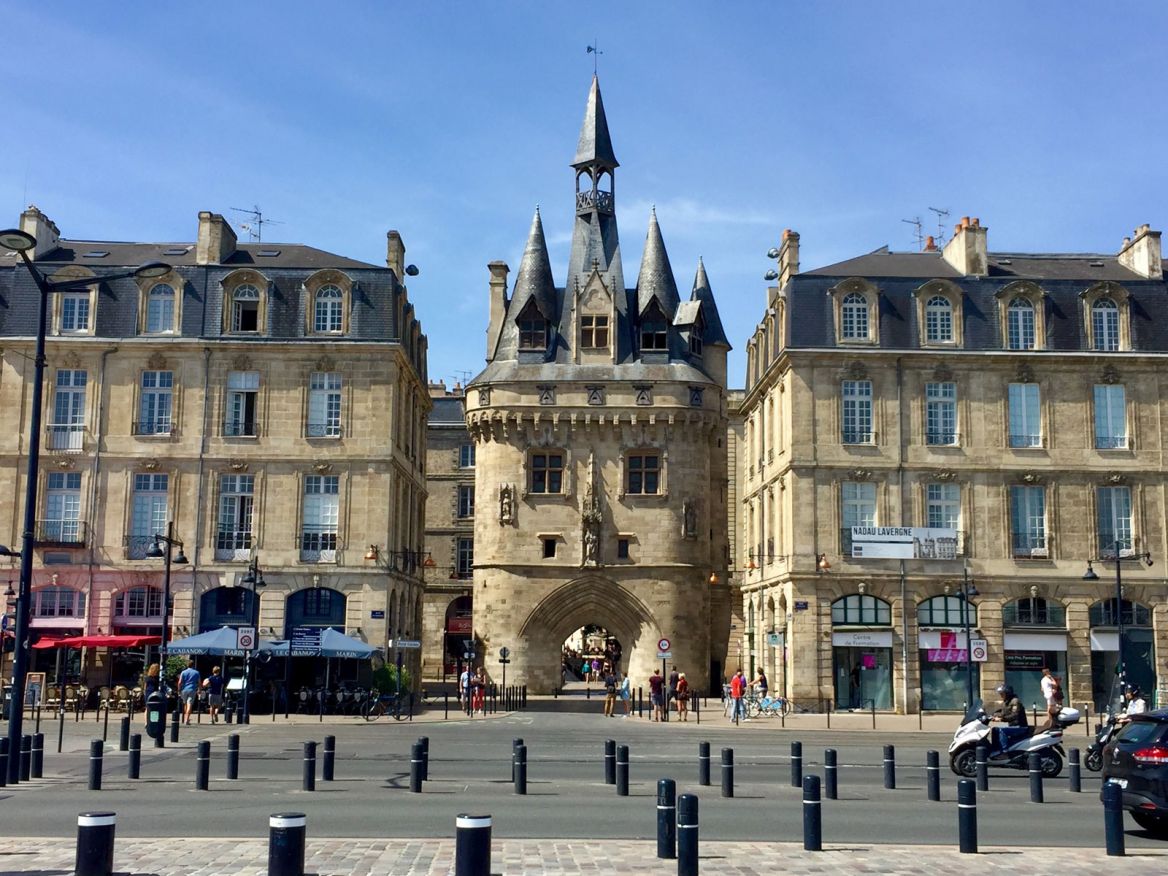- Home page
- Tourism
- Discover
- Visit Gironde
- Bordeaux and its surroundings
- Visit Gironde
- Discover
- Tourism
Bordeaux and its surroundings
Automatic translation
Bordeaux, classified as a world heritage site
"Bordeaux is without a doubt the most beautiful city in France", as Stendhal wrote in Voyages dans le midi, Bordeaux seduces and has become over time a tourist destination in its own right. Its tourist numbers have also doubled in 5 years.
Bordeaux was classified, like the Port de la Lune, as a UNESCO World Heritage Site in 2007. Labeled a City of Art and History, it has no fewer than 347 listed buildings, architectural gems from the 18th century.
The Saint-Jean station (formerly the Midi station), built in 1855, as well as its metal glass roof covering the tracks, have been listed as historic monuments since 1984.
Bordeaux has also opened up to the river and since 2006 its quays have offered one of the most beautiful walks. The revival of the tram, with its first lines inaugurated in 2005, has also largely contributed to restoring the city to its former glory. The buildings and their facades have regained their splendor, it is pleasant to stroll around the city, to go shopping on the Cours de l'Intendance or in the very commercial Rue Sainte Catherine, 1.2 km long, to stroll, on foot or by Velib, in the districts of Chartrons, Saint-Eloi, Saint-Michel, to sit on a café terrace or to go to a show at the Grand Théâtre.
The water mirror of the Place de la Bourse, the narrow streets of the protected sector, the Pey Berland tower, the Porte Cailhau, the big bell, the Place Royale, the Allées de Tourny, the Rue Sainte-Catherine… are all emblematic places to discover, as are its many museums.
The latest being the Cité du Vin, to the north of the historic centre, the fruit of 7 years of work, which opened its doors in June 2016 and reminds us that Bordeaux is also the world capital of wine. Bordeaux is an endearing city, with a certain charm, attractive and dynamic.
On the first Sunday of each month, the city center of Bordeaux is closed to traffic. It is the perfect time to discover or rediscover this city so dear to the hearts of the Aquitains.
 Visit the must-see places in the historic heart of Bordeaux, on foot or by tram, following a precise itinerary tested by our blogger. Read our article on her walk in Bordeaux.
Visit the must-see places in the historic heart of Bordeaux, on foot or by tram, following a precise itinerary tested by our blogger. Read our article on her walk in Bordeaux.
Some must-see places
The alleys of Tourny
These wide avenues planted with lime trees with a row of 18th century facades were laid out by Louis Urbain Aubert, Marquis de Tourny in 1745. These eponymous avenues host many events and are a pleasant place for a stroll.
The Quinconces Square
The largest square in Europe with its 12 hectares, located in the city center, it was developed following the dismantling, during the Restoration, of the Château Trompette.
The esplanade owes its name to the trees planted in staggered rows.
It has rostral columns (decorated with ship's spurs) to the glory of navigation and commerce and an imposing monument to the Girondins and the Republic with a fountain topped by a column.
The busts of the philosophers Montaigne (mayor of the city) and Montesquieu (magistrate in the parliament of Bordeaux) are erected on the square where many events take place throughout the year.
The Stewardship Course
Several private mansions were built there in the 18th century. Today, luxury boutiques have taken over the premises. The Cours de l'Intendance links the Place de la Comédie to the Place Gambetta. At number 19, the Passage Sarget dates from 1878, at number 57 the painter Goya died.
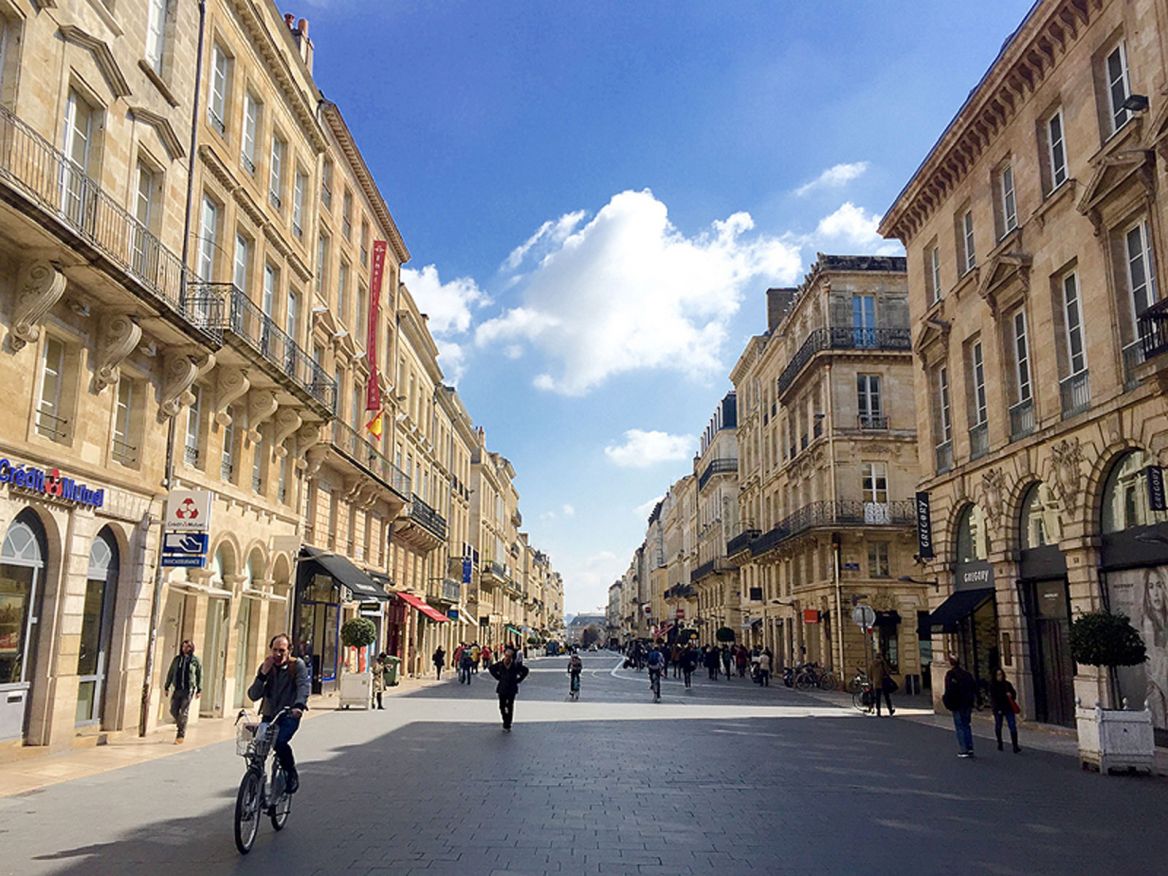
The Stock Exchange Square
We are tempted, and rightly so, to consider it the most beautiful square in Bordeaux because of the architecture of its buildings. Built in the middle of the 18th century by the architect Gabriel and dedicated to Louis XV, where his statue was enthroned, dismantled during the Revolution and replaced in the 19th century by the three graces.
It housed the customs and the maritime exchange. Bordeaux traded with Africa, it exchanged glass beads for slaves, delivered to the Antilles for coffee, cotton, cocoa, re-exported to the countries of the North.
The water mirror, made of granite covered with a thin film of water, created in 2006 is a true work of art that we owe to the architect Michel Courajoud and the fountain builder Jean-Max LLorca. It makes children happy when the weather is nice.
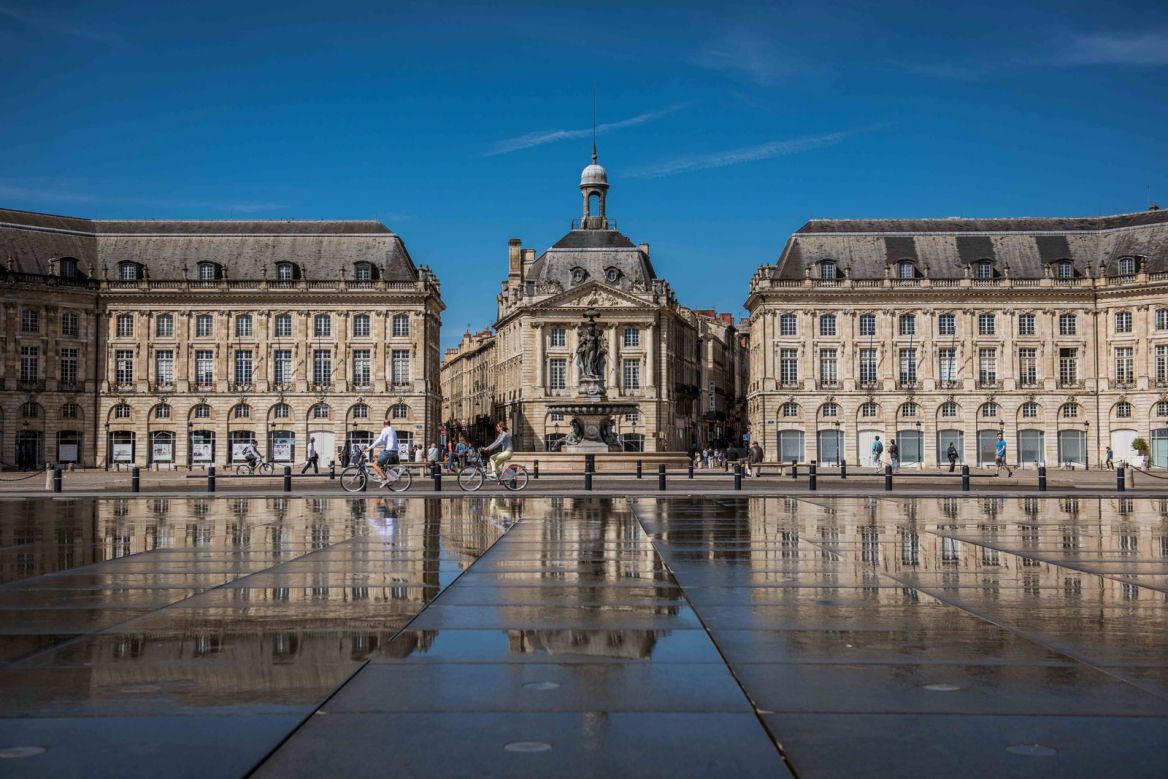
Parliament Square
Very lively, it was built in homage to the parliament of Bordeaux and has a Second Empire fountain. By taking the rue du parlement Saint-Pierre, you come out onto the place Saint Pierre and its eponymous district, open to the Garonne and full of history. The square, filled in in the 12th century, was home to the Gallo-Roman port.
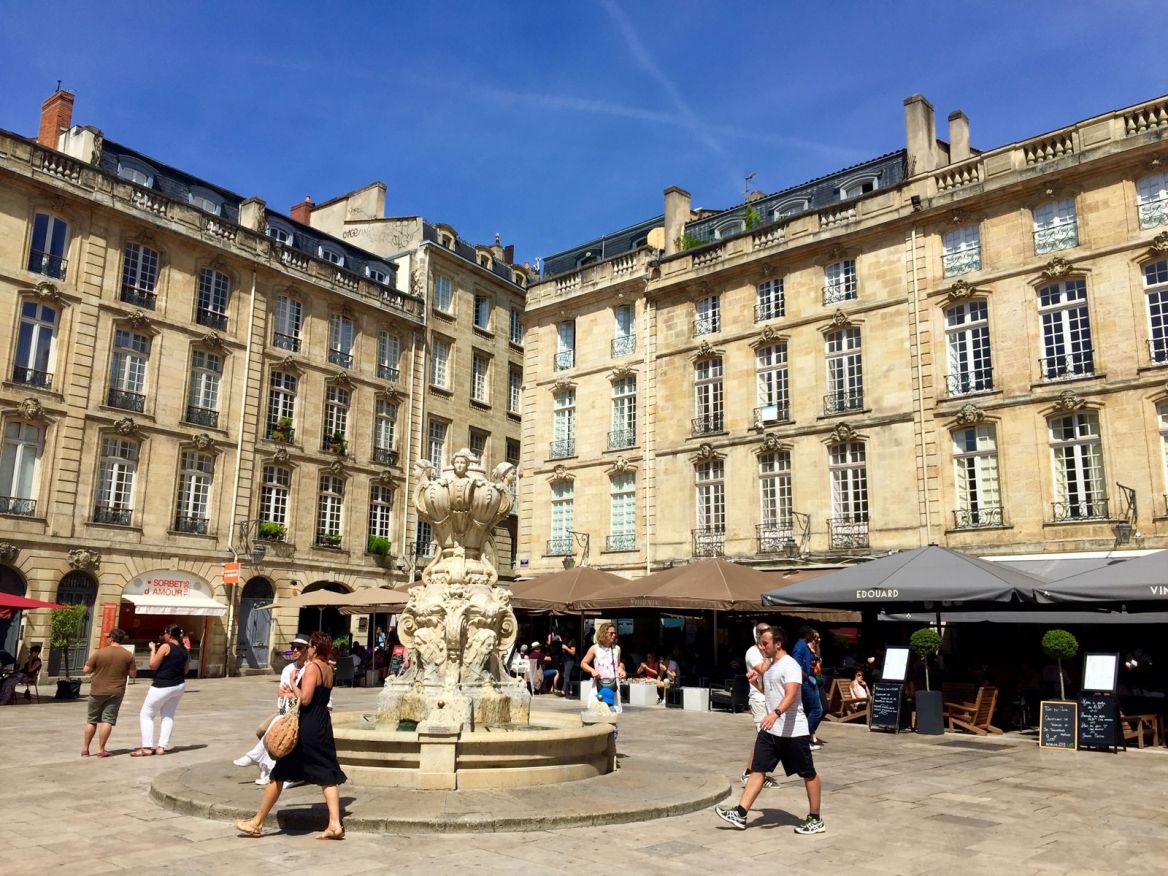
Palace Square
It owes its name to the 11th century fortress, of which today only a defensive tower remains, transformed into a triumphal arch in 1496, to commemorate the victory of Charles VIII at Fornovo in Italy: the Cailhau gate.
Pey Berland Square
Completely renovated in 2004, it is home to the Pey Berland tower, built in the 15th century, named after the archbishop, and the Saint André cathedral.
The superbly sculpted Pey Berland Tower is actually the bell tower of the cathedral, which was built separately. At the top of the tower, 50 m away, there is a magnificent view of Bordeaux and its monuments.
The cathedral was built on the ruins of a Romanesque building from the 11th century. It was in the Romanesque part that the marriage of Eleanor of Aquitaine and Louis VII, the future King of France, was celebrated in 1137.
The Gothic choir and the nave date from the 14th and 15th centuries. The cathedral has been a UNESCO World Heritage Site since 1998. Opposite the religious building is the Palais Rohan, built in 1771 and currently the town hall.
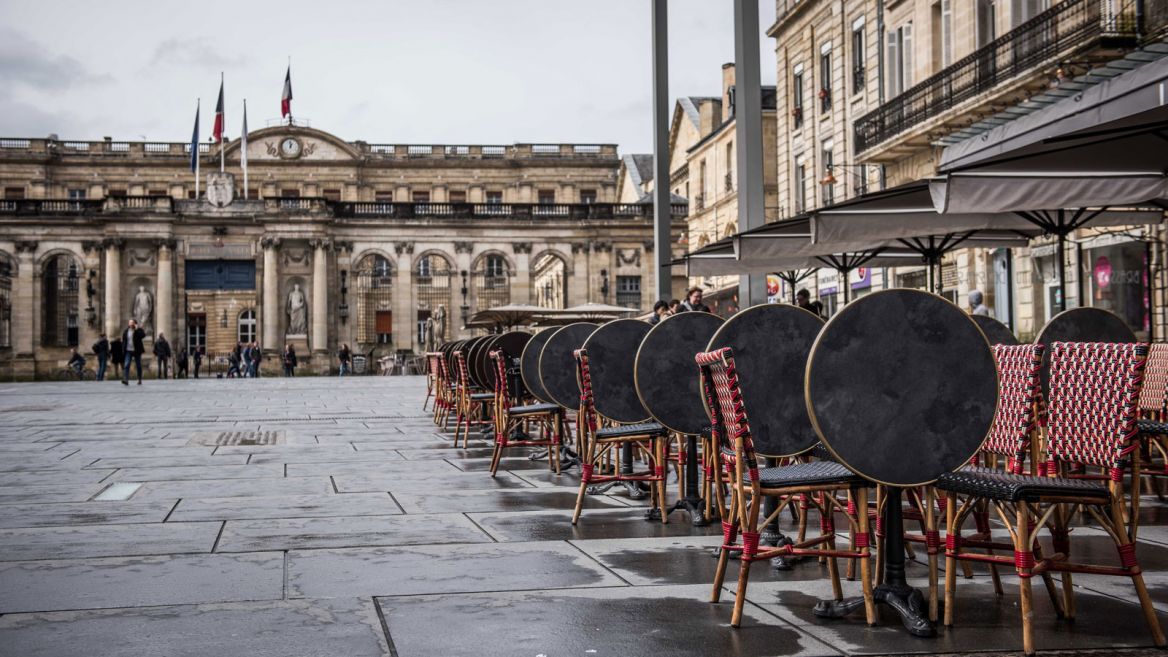
 The Pey-Berland tower can be visited. Visits are organized every day, the times vary according to the periods. The price of the ticket for adults is €6, it is free for under 18s. Read our article.
The Pey-Berland tower can be visited. Visits are organized every day, the times vary according to the periods. The price of the ticket for adults is €6, it is free for under 18s. Read our article.
Saint-Michel Square
Renovated in 2015, it is a picturesque and cosmopolitan place, in the heart of the popular district of Bordeaux. The square is home to the flamboyant Gothic style Saint-Michel basilica and its separate bell tower which dominates at 47 m high the city, the river and the architectural details of the basilica which is among the stages of the routes of Santiago de Compostela and is classified as a UNESCO World Heritage Site. The square hosts daily markets.
The Grand Theatre
Built at the end of the 18th century, according to the plans of the architect Victor Louis, at the request of the Duke of Richelieu, it was erected on the Place de la Comédie.
Its façade is made up of 12 Corinthian columns topped with statues of muses and goddesses. Listed as a historic monument, the grand theatre was restored in 1990.
Inside, the large vestibule is decorated with 16 Doric columns supporting a flat vault with coffers and rosettes. 5 arches provide access to the grand staircase which, a little less than a century later, would inspire Charles Garnier for that of the Paris Opera. From September to July, it hosts concerts and operas.
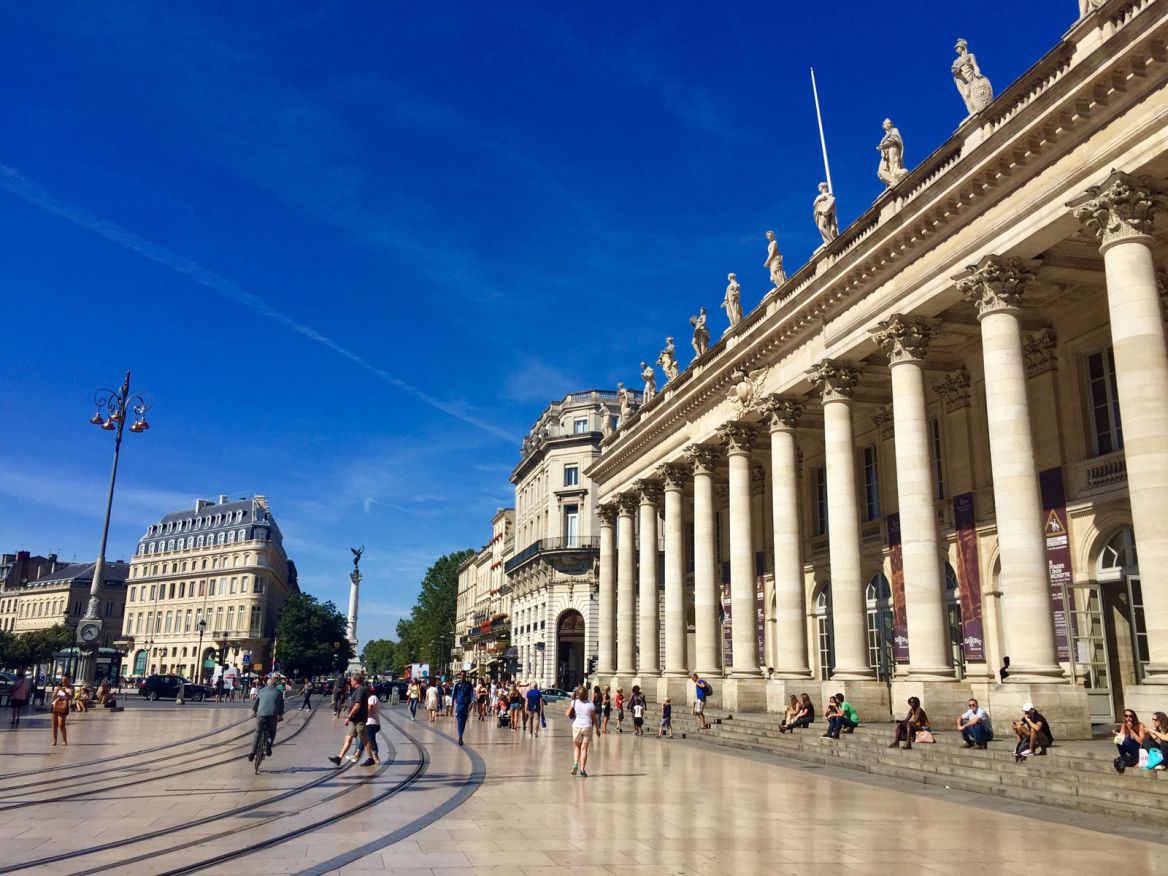
The Stone Bridge
Built on the orders of Napoleon Bonaparte between 1810 and 1822, it was the first bridge over the Garonne, connecting the right bank, Bastide district, to the city.
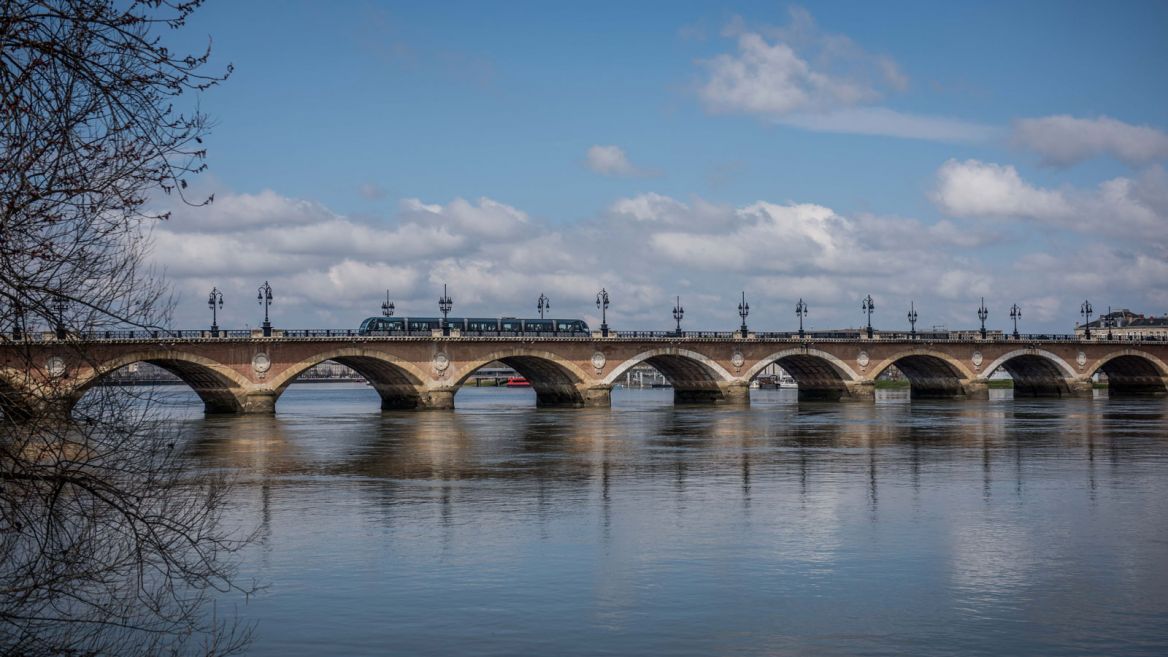
The Big Bell
It is the only vestige of the second city wall built in the 12th century, it has undergone many transformations. Its bells had a defensive role, they also announced the start of the grape harvest. It constitutes the symbol of the city which appears on the city's coat of arms.
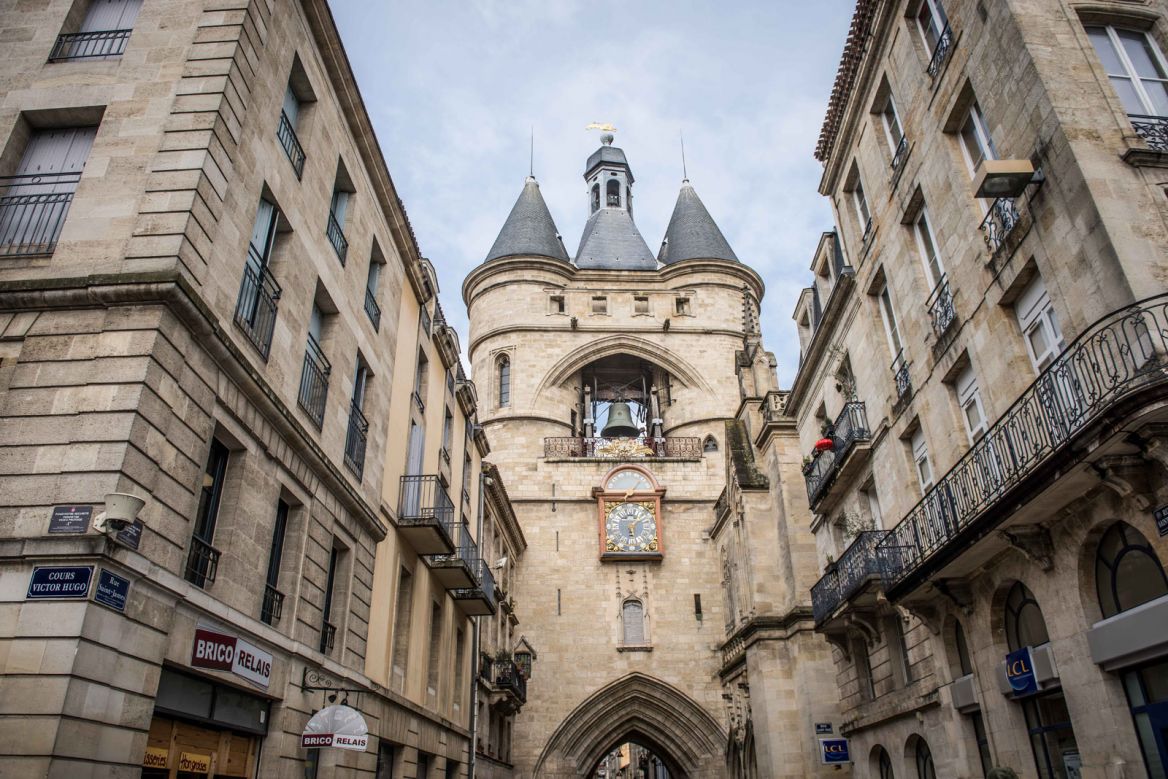
The Basilica of Saint-Seurin
Excavations have uncovered a vast Gallo-Roman Christian necropolis. It is one of the oldest churches in Bordeaux, its porch and crypt date back to the 11th century. The site is classified as a UNESCO World Heritage Site, located on the paths of St Jacques de Compostelle.
The Gallien Palace
These are the remains of the amphitheater of ancient Burdigala. Today, only a few bays and arcades remain of this 2nd century monument.
The public garden
It was designed by the architect Gabriel on commission of the intendant Tourny in the 18th century. English-style park with groves, ponds, games for children... In 1858 a botanical garden was established in its heart, rich in 3,000 plant species.
It has a puppet theatre that delights children. It is labelled a Remarkable Garden. Since 2007, in the Bastide district, a botanical garden has completed the historic establishment.
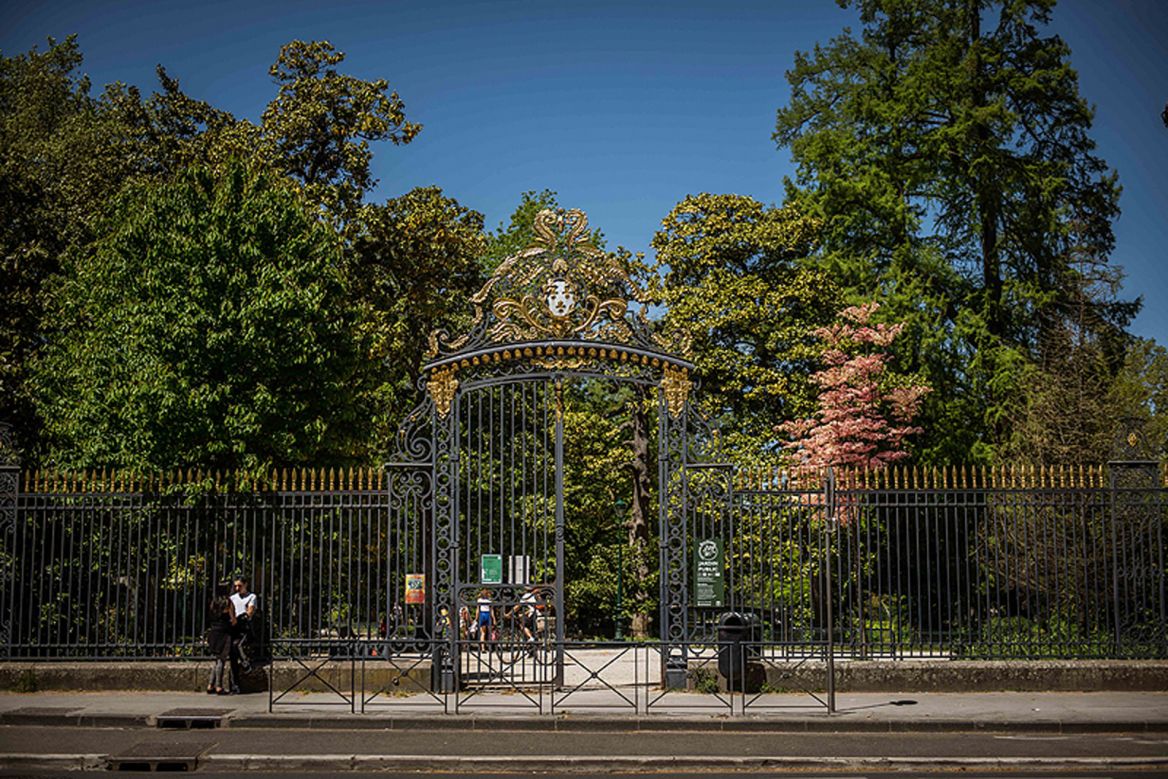
The Jacques Chaban Delmas Bridge
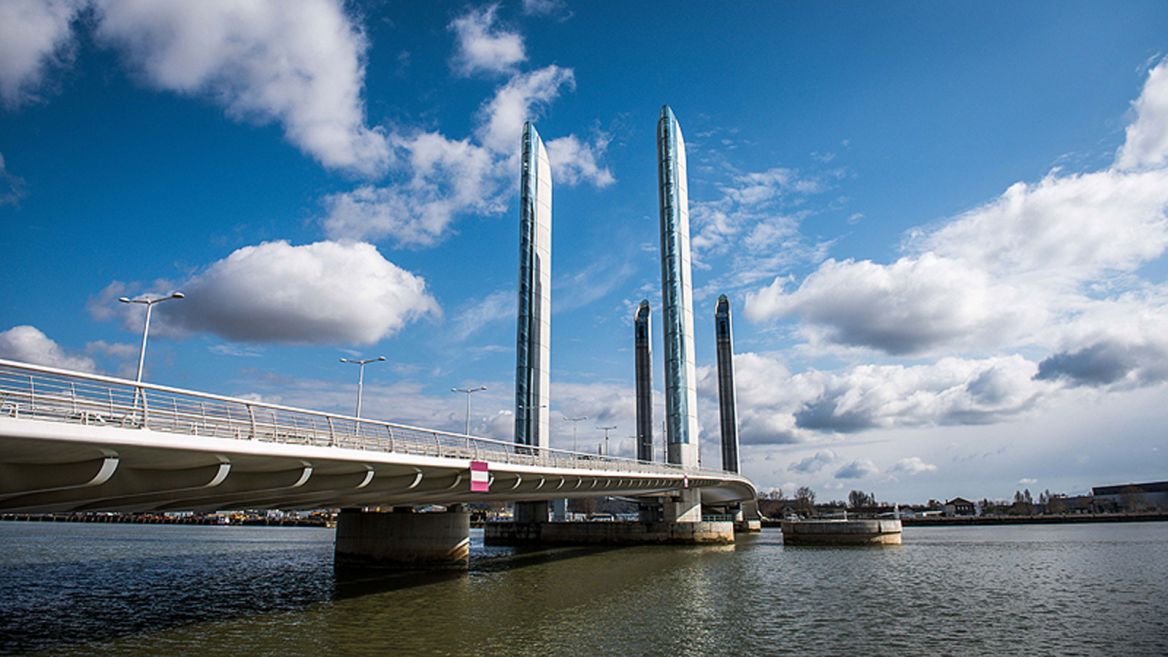
Named after the former mayor, this bridge is a curiosity. It is impressive when its central span rises to let cruise ships pass that will moor at the port. Since 2013, it has connected the Bacalan (Bordeaux maritime) and Bastide districts. Pedestrians and cyclists use it for walks that allow you to admire Bordeaux's left and right banks.
In keeping with its heritage, Bordeaux has a very active cultural life with no fewer than 11 museums dedicated to fine arts, contemporary art, decorative arts and design, customs, etc.
The City of Wine
It is not strictly speaking a museum, it is an emblematic place of excellence and a real gateway to the Bordeaux vineyards which opened its doors in June 2016, on the site of the old forges of the large maritime port of Bordeaux, in the Bacalan district, from the Bassins à Flot.
It is also on the left bank that we discover the submarine base, built during the Second World War, which hosts temporary exhibitions and cultural events.
The Aquitaine Museum
Located on Cours Pasteur, historical and ethnographic, traces the history of Bordeaux and its region, from prehistory to the present day. Rooms recall Atlantic trade and slavery.
The Museum of Contemporary Art
It offers temporary exhibitions and meetings around the history of art, music or contemporary creation all year round. It is located in the Chartrons district. Formerly a mecca of wine trade, its old warehouses have been rehabilitated. Today it is a very trendy district.
It is also in a renovated hangar in this district, on the banks of the Garonne, that Cap Sciences, a multidisciplinary place dedicated to science, has taken up residence.
Finally, in the heart of Bordeaux, you won't want to miss the 17th century Labottière mansion, owned by Bernard Magrez, a key figure in the world of wine, which houses a 5-star hotel, a gourmet restaurant "La grande maison" opened at the end of 2014 and boasting two Michelin stars (recently taken over by Pierre Gagnaire), and a cultural institute for contemporary art exhibitions and conferences throughout the year.
The capital of Bordeaux has two other Michelin-starred restaurants: Gordon Ramsay has taken the reins at the Pressoir d'Argent (1 Michelin star), and the Pavillon des boulevards (1 Michelin star) with the creative cuisine of Denis Franc.
New York New York
New York New York
N ew York New York : Friendly atmosphere and home cooking In the heart of Bordeaux, a stone's throw from Place Pey ...
229 m - Bordeaux
Mama Shelter Bordeaux
Mama Shelter Bordeaux
In Bordeaux, Mama is an atypical place, where everyone feels at home. Nestled in the hyper-city center between Pey ...
333 m - Bordeaux
Mama Shelter Bordeaux
Mama Shelter Bordeaux
In Bordeaux, Mama is an atypical place, where everyone feels at home. Nestled in the hyper-city center between Pey ...
334 m - Bordeaux
An agglomeration, the green lung of the city
Bordeaux Métropole brings together 28 municipalities spread over both banks of the Garonne. It currently has 749,595 inhabitants around its central city, Bordeaux (243,626 inhabitants). Half urban, half nature, to be discovered thanks to its 140 km of marked routes. You can even spend a night in peri-urban shelters
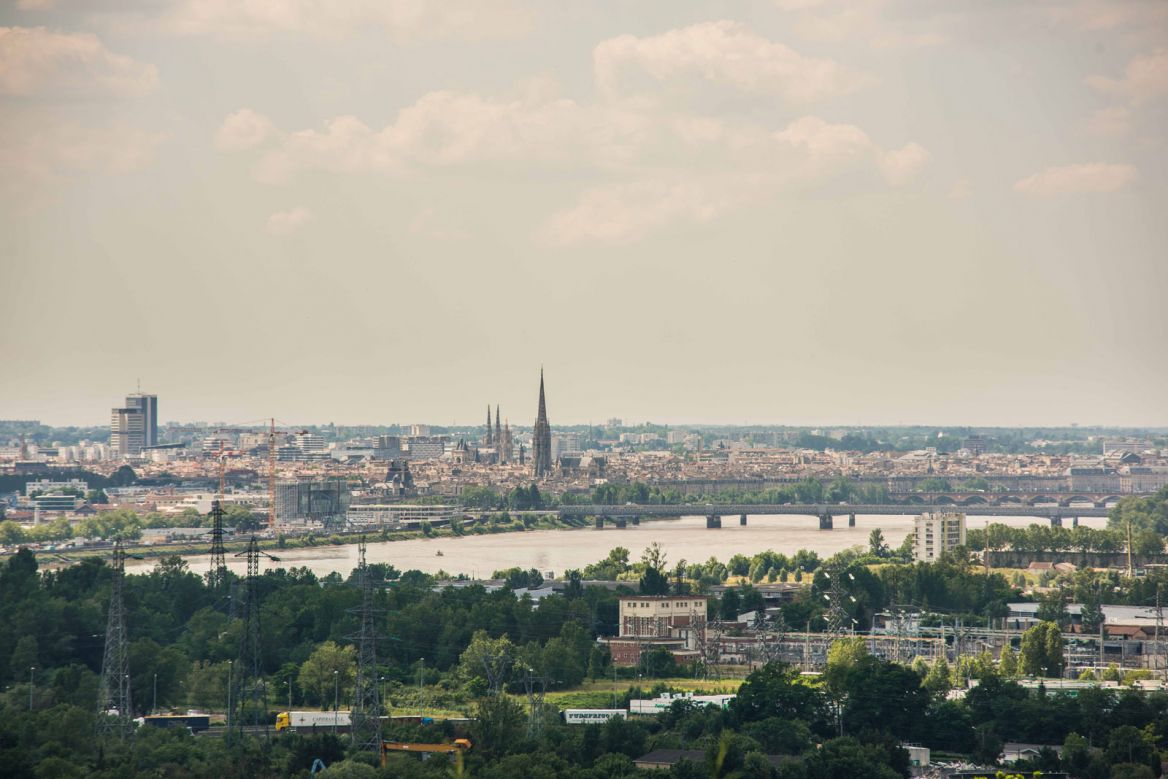
Pessac is both wine châteaux: Château Haut-Brion, Château les Carmes Haut-Brion, Château Haut-Brana, Château Pape-Clément… which have made the region famous and are gradually opening up to visitors, a university campus, an 11th century town centre, a district, the Cité Frugès, which we owe in the 1920s to the famous architect Le Corbusier, but also a zoo.
Mérignac was a Gallo-Roman city. Today, it is the most populated municipality in the Bordeaux metropolitan area with 68,000 inhabitants and an international airport. Several international company headquarters are located on its territory. With 8 eco-certified parks, 3 vineyards and a green belt of 844 hectares, Mérignac is a green city. The town hall parks (9 hectares) and that of Bourran, classified as a historic monument, are worth discovering.
Le Bouscat, is located northwest of Bordeaux. For a long time a small hamlet that only had a church in 1820. It is in Le Bousact that the Bordeaux racecourse is located. The Chêneraie park, a historic monument, and the Hermitage park are places to discover, as is the Villa Jeanne, a house built in 1898 by the architect Bertrand-Alfred Duprat, listed as a historic monument in 2001.
Saint-Médard-en-Jalles, hosted Roman camps. In the 17th century, a powder mill was installed which is still in operation today. The town has many streams where powder mills were once located.
With its 8,500 hectares, it is the largest locality in the Bordeaux metropolitan area. To visit: the 11th century church built on a Merovingian necropolis, its confessional is listed as a historical monument.
Cenon offers 25 hectares of greenery and a panorama of the Garonne with the Palmer park, an unmissable place for all lovers of nature but also music with the Le Rocher de Palmer performance hall.
Lormont, located on the right bank of the Garonne, the city has preserved traces of a very ancient past. First a defensive site then a fishing port in the 12th century. In the 18th century Lormont was the most important suburb of Bordeaux, its picturesque landscapes and the liveliness of its guinguettes were very popular. At the beginning of the 20th century, it became a place of residence and vacation for the people of Bordeaux. The old town, with its superbly restored wash houses, its churches, is classified as an Urban and Landscape Architectural Heritage Protection Zone, guided tours are organized by the Tourist Office. The Hermitage Park, a biodiversity area, with its 28 hectares is the green lung of the City. The Friends of Old Lormont Museum has a rich collection of objects on its history.
Bouliac, is a town at the gateway to the Entre-deux-mers. With its preserved environment, it is the perfect example of a town in the countryside. Bouliac has been occupied since the Gallo-Roman period. Its Saint-Siméon le Stylite church is a pure jewel of Romanesque art. 30 kilometers of hiking trails allow you to crisscross the town.
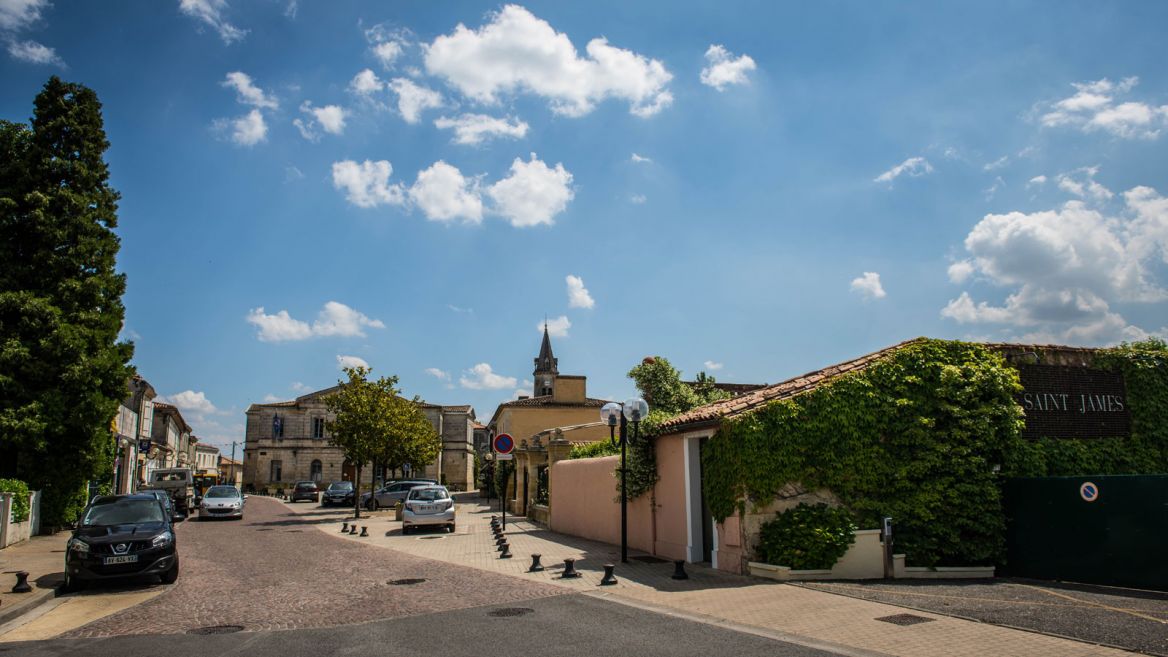
Bègles, located on the left bank of the Garonne, was once a fishing port, known for its cod drying sheds. Bègles had easy access to unload cod caught in Newfoundland or Iceland.
It was the first industrial suburb of Bordeaux, the most populated until before the Second World War. It is also a wine-growing commune, producing the Graves vineyard. Bègles is proud of its art-deco swimming pool built in 1932, listed in the inventory of historical monuments and its rugby club CA Bordeaux-Bègles was champion of France in 1991.
The town has a network of 30 km of cycle paths and three flowers in the village and villages fleuris label.
From mid-June to the end of August, Bègles offers the Bègles Plage animation, around its lake: 1,000 m2 of supervised swimming, with a depth of only 1.80 m, sports and nature activities in town. Its museum of frank creation, a museum of raw art, created in 1989, has a collection of 14,000 contemporary, heterogeneous works, born from the spontaneous desire of artists, famous or unknown, to simply express themselves.
Blanquefort, at the gateway to the Médoc, has many green spaces, including 51 hectares of parkland and has 4 flowers in the label of cities and villages in bloom. It is also, with 220 companies, the economic activity zone, the largest in the agglomeration.
Goélia - La Marina de Talaris
Goélia - La Marina de Talaris
In an exceptional setting, in the heart of a pine forest and 900 meters from Lake Lacanau, the Goélia residence "La ...
Lacanau
Goélia - Le Cordouan
Goélia - Le Cordouan
For a stay close to the beaches and the city center, discover the 3*** "Goélia Le Cordouan" Tourist Residence ...
Soulac-sur-Mer
Résidence Vacanceole les Rives du Lac***
Résidence Vacanceole les Rives du Lac***
Welcome to the residence Les Rives du Lac*** ! In a natural setting, 100 meters from the beaches of Lake Lacanau and ...
Lacanau


